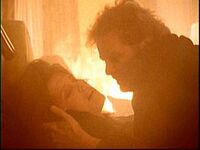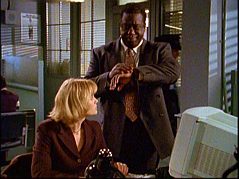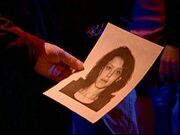
Janette collapses after she is shot.
There is still some controversy over the best way to interpret the final scenes of "The Human Factor" and their implication for the fate of Janette DuCharme.
Janette was a regular character in Seasons One and Two, but she left Toronto shortly before the start of Season Three. Flashbacks in "The Human Factor" tell her activities thereafter: she had moved to Montreal, fallen in love with an arson investigator named Robert McDonagh, and then turned mortal from the shock and grief she felt when he was murdered. She returned to Toronto in pursuit of the man she blamed for his death.
At the end of the episode she was shot and fatally injured, so Nick offered to bring her back across. However, the final scenes are ambiguous. Did Janette die? Or did she survive as a vampire?
The Plot of "The Human Factor"[]

Janette takes the key to the locker after shooting Larouche.
At the beginning of "The Human Factor", Janette shoots Mario Larouche, the man she blames for the death of Robert McDonagh. She then removes an envelope from his briefcase, and takes from it the key to a locker in the Civic Centre where Larouche has placed evidence identifying his employer. Having left Robert's son, Patrick, with his aunt, Peggy Bolger, in Uxbridge, Janette goes to the Civic Centre with the intention of collecting the evidence. As she arrives, however, her car is shot up by members of the arson ring, who are also after the evidence.

When Nick and Janette try to recover the evidence from the locker, they are ambushed by the arsonists.
Abandoning the vehicle, Janette flees to Nick's loft. There she spends the day. He lets her take his bedroom, while he sleeps on the couch. The following evening, he calls in sick, and goes with Janette to the Civic Centre. However, the arsonists are lying in wait.
Though Nick and Janette are unable to collect the evidence, the arsonists are not able to get it either: they do not know which locker it is in; and they do not have the key. They do, however, have sufficient information on Janette's deceased lover to be able to plot a course of action. They go to Peggy Bolger's house, take her and Patrick prisoner, tie them up, and telephone Janette that they want to make a swap. Nick and Janette drive to Uxbridge, and hand over the key.

Nick frees Patrick and his aunt so they can flee the burning house
The arsonists, however, have no intention of leaving witnesses. They shoot Janette and Nick, and set fire to the house. Being a vampire, Nick is unhurt. He frees Patrick and his aunt, who rush out to safety, and then goes to Janette, lifting her up—perhaps to carry her out of the house. However, she is dying. Nick therefore offers to bring her back over. She refuses, falling back unconscious or dead. He throws back his head and screams in anguish.
The Question[]

When Larouche murdered Robert McDonagh, Janette's anguish turned her mortal.
Did Janette die at this point?
There is a cinematic convention that, when someone who is desperately injured finally collapses, this signals their death. Indeed, the conclusion to the final act strikingly parallels the flashback to the death of Janette's lover in Montreal: he too collapsed; she too screamed. And he died. In this circumstance, it is not surprising that many fans initially assumed that "The Human Factor" concluded with Janette's death. This is the more true considering that there were many among them who did not see all of the tag, since it was cut in some markets.
It is now known that the intent of the creative team working on the episode was to indicate subtly in the tag that Janette had been brought across by Nick. However, one needs to distinguish between intent and canon. Something is only properly considered to be canonical if it actually appears on screen. It is necessary, therefore, to examine the internal evidence that has been adduced to prove that Janette survived.
Briefly, the significant scenes of the tag are these:
- Captain Reese wakes Nick with a phone call, telling him to come over to the Civic Centre.
- There Nick finds that the arsonists have been killed by a vampire.
- Nick then shows Janette's portrait to LaCroix, telling him that she must have brought it over to the loft earlier that day.
- LaCroix says to Nick, "It seems that I have lost a daughter but regained a son".
Discussion of the Evidence[]

Nick books off sick so that he can be with Janette.
The epilogue or tag of "The Human Factor" opens with Nick asleep at home. He is abruptly awakened by his phone ringing. It is Captain Reese, who impatiently orders Nick to come to the Civic Centre. This has been taken to indicate that the tag occurs the night after the rest of the episode, since Nick had booked off sick in order to help Janette. On the other hand, it is hardly a secret that people claim to be ill when they actually just want time off work. If Nick were truly sick, he might be quite unfit to go to the crime scene; but Reese probably suspects that he has simply taken some personal leave. The murders at the Civic Centre are a major development in the case: there is no way Reese can continue to wink at Nick's absence: he has to call him in. As evidence of timing, therefore, the phone call has to be considered equivocal: whether the same day or the next day, Reese would still be calling Nick.

The crime scene by the lockers is still actively being processed when Nick arrives at the Civic Centre.
So when were the arsonists killed? As the crime scene is still actively being processed, the bodies cannot have been found too many hours earlier. The case clearly has not been assigned to day shift detectives, nor is there evidence that it was originally so assigned before the connection with Larouche's murder was made.
The arsonists got the key (and set fire to the Bolger house) at night. Would they have waited all day in order to go to the Civic Centre the following evening? They had to know that the arson at Peggy Bolger's house would be investigated by the police; and they couldn't be sure what evidence might be found there, since some parts of the house might well have survived the fire. This might even include things left by Janette. (Certainly, they don't know that she spent the night at Nick's apartment.) Furthermore, their employer, a Toronto real-estate developer, would want the evidence in the locker recovered as soon as possible.
It seems more likely, therefore, that the murderers went straight to the Civic Centre from Peggy Bolger's house. They took the key to the locker, and were killed there. Their bodies were left where they died. And so they were found there, either with the locker door open or with the key ready to hand so that the right locker could be identified. It is true that, by the time Nick got there, the bodies had already been put in body bags. But Nick, as we know, arrived late at the scene. Presumably, by that time, Natalie had already inspected the corpses, and Tracy and Captain Reese had okayed their being bagged.

Nick shows LaCroix the portrait of Janette.
The timing here is important because, when Nick shows LaCroix the portrait of Janette, he tells him that Janette must have brought it to the loft "earlier today". If the murders at the Civic Centre and Reese's phone call to Nick take place the day after the rest of "The Human Factor", then "today" would be the day after Peggy Bolger's house burned down—that is to say, the day after Janette was shot, and apparently killed. For her to bring the painting to the loft, therefore, she would have to have survived, meaning that Nick would have had to have brought her across. This is seen by some fans as critical evidence indicating that Janette was brought across by Nick, and is therefore alive as a vampire.

Janette slept separately from Nick.
On the other hand, if the arsonists were killed shortly after the fire at Peggy Bolger's (and Captain Reese therefore telephoned Nick an hour or two after that), Janette could have brought the painting to the loft during the day before her death, some time while Nick was asleep on the couch. If so, the timing of the phone call is irrelevant to the question of Janette's survival. She would have brought the picture to the loft while she was still mortal—whether or not she was later brought over by Nick.
Who killed the arsonists? We know it was a vampire, since Natalie saw the bite marks. And, of course, if Janette has indeed been brought over, then she is by far the likeliest avenger. This is the usual interpretation made by fans, especially since it presupposes her survival. Who is there as an alternative?

When Nick showed LaCroix the sketch of the suspect, he refused to believe Janette was in Toronto.
It is unlikely that it was LaCroix who killed the arsonists. Not because it is in any way out of character: indeed, if Janette should have been killed, there is nothing more likely than that LaCroix would take revenge on her murderers. However, when Nick went to him with the sketch of Janette, he did not believe that she had returned to Toronto.
The other possibility is Nick. When he shows LaCroix the Janette's portrait, LaCroix's response is to say, "It seems that I have lost a daughter and regained a son." There are two possible ways to take this. If Janette has been brought across by Nick, then she is no longer LaCroix's daughter but Nick's. On the other hand, if she is dead (and thus lost), LaCroix could be referring to Nick's decision to take revenge on the arsonists when he had sworn never to kill again. Or even a combination of the two: He lost a daughter because she is now Nick's child and he has regained a son because Nick has brought someone across.
Conclusion[]
The final scenes of the last act and tag have been perused closely by fans seeking certain evidence of one or the other interpretation. The evidence has been weighed in the scales. But the truth is that no certainty can be found either way. Creative intention can be used to decide the issue in favour of Janette's survival as a vampire; but, within canon at least, the evidence is equivocal.
There is an appealing irony is Janette's unlooked for achievement of the mortality that has proven so elusive to Nick, only to lose it at Nick's fangs. There is equal irony in the idea of her achieving the mortality that Nick longs for, only to lose it so quickly to death. It is only an added irony that he can be held culpable for her being shot, in as much as, being a police officer, he should have guessed that the arsonists would not want witnesses, and, as a vampire, he could have stopped them.
Fans are, of course, delighted to learn that the creative personnel intended Janette to survive. She has always been one of the most popular characters in the series; and her departure at the end of Season Two had been regretted by many.
Fan Comments[]
Fan comments on "The Human Factor" include the following:
Janette was the epitome of the integrated vampire: strong, powerful, secure and content in what she was. That contrast was a necessary counterpoint to Nick's leanings toward mortality and LaCroix's penchance for control over them both. To have Janette lose so much in becoming mortal was both cruel and unbelievable. She might as well have been staked. And the "method" by which she became mortal was so flimsily explained that it's an insult to the watchers to be asked to believe it." — comment by Marcia T. on Our Dark Lady of Forever Knight[2]
References[]
- ↑ These comments on "The Human Factor" come from the website, Our Dark Lady of Forever Knight, which devotes this webpage (archived) to them. (Accessed 6 July 2011)
- ↑ These comments on "The Human Factor" come from the website, Our Dark Lady of Forever Knight, which devotes this webpage (archived) to them. (Accessed 6 July 2011)